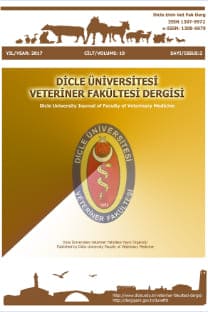Van'da Kesilen Boğalarda Testis Anomalilerinin Histopatolojisinin Değerlendirilmesi
Evaluation on the Histopathology of Testes Anomalies in the Bulls Slaughtered at The City of Van
___
- 1. Almquist JO, Amann RP. (1961). Reproductive Capacity of Dairy Bulls. II. Gonadal and Extragonadal Sperm Reserves as Determined by Direct Counts and Depletion Trials; Dimensions and Weight of Genitalia. J Dairy Sci. 44 (9): 1668-1678.
- 2. Aman RP, Veeramachaneni DN. (2007). Cryptorchidism in Com-mon Eutherian Mammals. Reproduction. 133, 541-561.
- 3. Willet EL, Ohms JI. 1(957). Measurement of Testicular Size and Its Relation to Production of Spermatozoa by Bulls. J Dairy Sci. 40 (12): 1559-1569.
- 4. Hahn J, Foote RH, Cranch ET. (1969). Tonometer for Measuring Testicular Consistency of Bulls to Predict Semen Quality. J Anim Sci. 29 (3): 483-489.
- 5. Coulter GH, Larson LL, Foote RH (1975). Effect of Age on Testicular Growth and Consistency of Holstein and Angus Bulls. J Anim Sci. 41 (5): 1383-1389.
- 6. Jainudeen MR, Hafez ESE. (1987). Reproductive Failure in Males, (in) Reproduction in Farm Animals, Hafez ESE (Editor). chapter 20 pp.423-435, Lea Febiger. Philadelphia.
- 7. Alpan O. (1994). Cattle Breeding. 4. Ed. Şahin Press, Ankara.
- 8. Ayodeji AA, Suwaiba W. (2013). Cryptorchidism Among Indige-nous Breeds of Bulls in A Semi-Arid Region of Nigeria. Maced Vet Rev. 36 (2): 123-128.
- 9. Kibar M. (2012). Male Genital System Surgeon. Veteriner Özel Cerrahi, 20. Bölüm, 333, Medipress, Malatya
- 10. Mc Entee K. (1990). Reproductive Pathology of Domestic Animals, Academic Press lns., San Diago, California.
- 11. Çiftçi KM, Çoyan K, Güven B, Yener Z, Karaca F, Türkütanıt S. (1996). Merinos Koçlarda Kritorşizm ve Testis Hipoplazisinin İnsi-densi ile Fertiliteye Etkisinin Patolojik ve Androlojenik Yönden İncelenmesi. Vet Bil Derg. 12 (2): 93-104.
- 12. Abu-Seida AMA. (2011). Ultrasonographic Diagnosis of Some Scrotal Swellings in Bulls. Pakistan Vet J. 32 (3): 378-381.
- 13. Yurdakul I. (2015). Kuzularda Atresia Ani et Recti. Turkiye Klinikleri Journal of Veterinary Sciences- Internal Medicine-Special Topics. 1(3): 89-92.
- 14. Koç Y, Alkan F. (2001). Clinical Evaluation of Testis, Penis and Preputium Diseases in Domestic Animals. Vet Bil Derg. 17 (4): 67-74.
- 15. Blanchard TL. (1990). Identification and Treatment of Scrotal Abnormalities, in Large Animals. Vet Med. 85: 82.
- 16. Boothe HW. (1993). Penis, Prepuce and Scrotum. (in) Textbook of Small Animal Surgery. Slatter, D (editor). pp. 1336-1348. Second Edition W.B. Saundres Company Philadelphia.
- 17. Reddy BS, Reddy VYP, Sivajothi S. (2019). Trans-Scrotal Ultraso-nography Evaluation of the Cross-Bred Ongole Bulls. Com Clin Pathol. 28:21-213.
- 18. Türkütanıt S. (1994). Konya Bölgesinde Mezbahada Kesilen Koçlar-da Testis ve Epididimis Patolojisi. Ankara Uni Vet Fak Derg. 41 (2): 280-298.
- 19. Bourgon SL, de Amorim MD, Chenier T, et al. (2018). Relationships of nutritional plane and feed efficiency with sexual development and fertility related measures in young beef bulls. Ani Rep Sci. 198: 99-111.
- 20. Penitente-Filho JM, Silva FF, Guimarães SF, et al. (2018). Relati-onship of Testicular Biometry with Semen Variables in Breeding Soundness Evaluation of Nellore Bulls. Ani Rep Sci. 196: 168-175.
- 21. Kaya A. (1999). Sperm Abnormalities in Bulls: Aetiology and Classification. Kafkas Univ Vet Fak Derg. 5 (2): 215-222.
- 22. Rahman MB, Schellander K, Luceño NL, Soom AV. (2018). Heat Stress Responses in Spermatozoa: Mechanisms and Consequences for Cattle Fertility. Theriogenology. 113:102-112.
- 23. Migbaru K, Sisay G, Kasa T. (2014). Study on Gross Testicular Disorders of Bulls Slaughtered at Addisababa Abattoirs Enterprise. J Reprod Infertil. 5 (2): 45-49.
- 24. Ramamohana Rao AP, Narasimha R, Rajulu PS. (1966). Testicular Hypoplasia in A Cross-Bred Bull. Indian Vet J. 43:778-781.
- 25. Kılıçoğlu SÇ, Kökuslu C. (1972). Testicular Hipoplasia in a Bull. Ankara Uni Vet Fak Derg. 19:85-91.
- 26. Keleş ÖF. (2016). Mezbahada Kesilen Koçlarin Orşitis ve Epididimitisleri Üzerine Makroskobik, Mikroskobik ve Immunohistokimyasal Incelemeler. YYÜ Health Sciences Institute, Master Thesis, Van, TURKEY.
- 27. Burgess GW. (1983). An Abattoir Survey of Lesions in The Scrotal Contents of Rams. Austr Vet J. 60 (3): 85-86.
- 28. Foster RA, Ladds PW, Hattman D, Briggs GD. (1990). Pathology of The Reproductive Tract of Merino Rams in Northwestern Queens-land. Austr Vet J. 66:262-264.
- 29. Kumi-Diaka J. (1979). Clinical and Anatomical Studies on the Scrotal and Pelvic Genitalia of Sokoto Gudali Bulls in Northern Nigeria. Res Vet Sci. 26:122-123.
- 30. Yeşildere T. (1980). Kısırlık Nedeni ile Zorunlu Kesime Yollanan Boğalar ile Mezbahada Kesilen Boğalarin Testis ve Epididimislerin-de Görülen Anatomo-Histopatolojik Lezyonlar. İstanbul Uni Vet Fak Derg. 6: 85-94.
- 31. Ahmad M, Ahmad N, Anzar M, Khan IH, Latif M, Ahmad M. (1988). Post Mortem Studies on Infertile Buffalo Bulls: Testicular Histo-logy. Vet Rec.122: 229-231.
- 32. Keleş H. (2002). Pathological Investigations on The Inflammatory Changes of the Testis and Epididymis of the Bulls Cut in the Van Region Slaughterhouses. YYÜ Health Sciences Institute, Master Thesis, Van, TURKEY.
- ISSN: 1307-9972
- Yayın Aralığı: 2
- Başlangıç: 2008
- Yayıncı: Dicle Üniversitesi Veteriner Fakültesi
Van İlindeki Sokak Köpeklerinde Gastrointestinal Protozoonların Prevalansı
Tuba Damla ERTAŞ, Serkan ERDOĞAN
Veteriner Doğum ve Jinekolojide Kullanılan Bazı Alternatif Tedavi Yöntemleri
NİHAT ÖZYURTLU, İBRAHİM KÜÇÜKASLAN
Van'da Kesilen Boğalarda Testis Anomalilerinin Histopatolojisinin Değerlendirilmesi
AHMET UYAR, BARIŞ ATALAY USLU, İBRAHİM YURDAKUL
Dicle Üniversitesi Veteriner Fakültesinin Öğrenci Profili Üzerine Bir Araştırma
ÖZGÜL KÜÇÜKASLAN, İLHAMİ BULUT
FERAY ALTAN, HANİFİ EROL, SEMİH ALTAN, Mustafa ARICAN, MUAMMER ELMAS, Kamil ÜNEY
Fonksiyonel Bir Gıda Olarak Tavşan Eti ve Önemi
